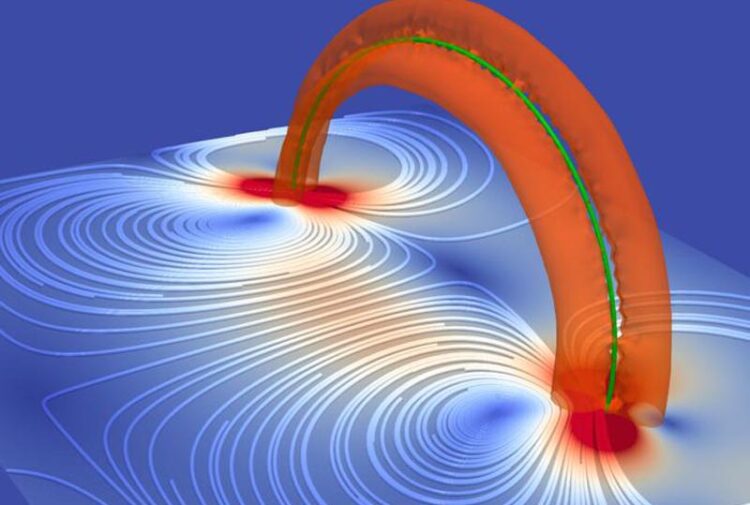Finally solved! The great mystery of quantized vortex motion

Visualization of quantized vortex ring above the plane (green curve), normal-fluid vortex rings (reddish half circles)
Credit: Makoto Tsubota, OMU
Explaining the interaction between quantized vortices and normal fluids.
Liquid helium-4, which is in a superfluid state at cryogenic temperatures close to absolute zero (-273°C), has a special vortex called a quantized vortex that originates from quantum mechanical effects. When the temperature is relatively high, the normal fluid exists simultaneously in the superfluid helium, and when the quantized vortex is in motion, mutual friction occurs between it and the normal-fluid.
However, it is difficult to explain precisely how a quantized vortex interacts with a normal-fluid in motion. Although several theoretical models have been proposed, it has not been clear which model is correct.
A research group led by Professor Makoto Tsubota and Specially Appointed Assistant Professor Satoshi Yui, from the Graduate School of Science and the Nambu Yoichiro Institute of Theoretical and Experimental Physics, Osaka Metropolitan University respectively in cooperation with their colleagues from Florida State University and Keio University, investigated numerically the interaction between a quantized vortex and a normal-fluid.
Based on the experimental results, researchers decided on the most consistent of several theoretical models. They found that a model that accounts for changes in the normal-fluid and incorporates more theoretically accurate mutual friction is the most compatible with the experimental results.
“The subject of this study, the interaction between a quantized vortex and a normal-fluid, has been a great mystery since I began my research in this field 40 years ago,” stated Professor Tsubota. “Computational advances have made it possible to handle this problem, and the brilliant visualization experiment by our collaborators at Florida State University has led to a breakthrough. As is often the case in science, subsequent developments in technology have made it possible to elucidate, and this study is a good example of this.”
Their findings were published in Nature Communications.
About OMU
Osaka Metropolitan University is the third largest public university in Japan, formed by a merger between Osaka City University and Osaka Prefecture University in 2022. OMU upholds “Convergence of Knowledge” through 11 undergraduate schools, a college, and 15 graduate schools. For more research news visit https://www.omu.ac.jp/en/ or follow us on Twitter: @OsakaMetUniv_en, or Facebook.
Journal: Nature Communications
DOI: 10.1038/s41467-023-38787-w
Method of Research: Computational simulation/modeling
Subject of Research: Not applicable
Article Title: Imaging quantized vortex rings in superfluid helium to evaluate quantum dissipation
Article Publication Date: 23-May-2023
Media Contact
Akane Kunida
Osaka Metropolitan University
koho-ipro@ml.omu.ac.jp
Original Source
All latest news from the category: Physics and Astronomy
This area deals with the fundamental laws and building blocks of nature and how they interact, the properties and the behavior of matter, and research into space and time and their structures.
innovations-report provides in-depth reports and articles on subjects such as astrophysics, laser technologies, nuclear, quantum, particle and solid-state physics, nanotechnologies, planetary research and findings (Mars, Venus) and developments related to the Hubble Telescope.
Newest articles

A universal framework for spatial biology
SpatialData is a freely accessible tool to unify and integrate data from different omics technologies accounting for spatial information, which can provide holistic insights into health and disease. Biological processes…

How complex biological processes arise
A $20 million grant from the U.S. National Science Foundation (NSF) will support the establishment and operation of the National Synthesis Center for Emergence in the Molecular and Cellular Sciences (NCEMS) at…

Airborne single-photon lidar system achieves high-resolution 3D imaging
Compact, low-power system opens doors for photon-efficient drone and satellite-based environmental monitoring and mapping. Researchers have developed a compact and lightweight single-photon airborne lidar system that can acquire high-resolution 3D…





















